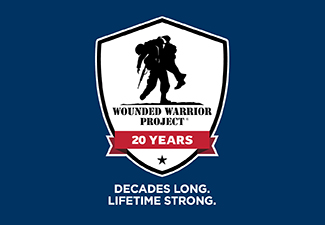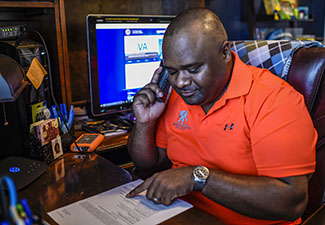A ‘Hand Up’ Not a Handout: Marine Veteran Finds Financial Stability and New Purpose

U.S. Marine John Casares’ landed in Iraq amid a burst of flames. And as frightening as that event was, it wasn’t John’s worst memory of war. Things didn’t get much better after he returned home, either.
The adrenaline of serving in the Marine Corps kept John focused, shielding him from the weight of his reality. But after leaving the military, all he had were his thoughts and the physical and emotional pain he was in. There was no mission, no job, no camaraderie, no purpose.
Sure, there were pills to take for his wounds, and often, alcohol would mask the pain the pills didn’t address. John knew it wasn’t the healthiest way to deal with his issues, but he also didn’t know how else to handle things.
When John registered with Wounded Warrior Project® (WWP), he realized that asking for help wasn’t asking for a handout but a “hand up.” The life-changing programs and services WWP™ provides helped John find work, regain his financial footing, improve his mental health, and rediscover his purpose. Feeling honored and supported, he’s now finding new ways to serve.
Service … and Sacrifice
John joined the Marines in 2002 after 9/11. He served in aviation ordnance, assembling and programing munitions like bombs, rockets, and missiles. In 2005, he deployed to Iraq. There was no question that entering an active war zone would be tough, but John admits it was hard to prepare for the welcome his unit received.

John paints his stepson's face at a Marines event in 2009.
As part of an aviation unit, John arrived in Iraq by C-130, escorted by helicopters to the landing zone. Upon arrival, enemy combatants began shooting at the aircrafts, causing a fuel bladder on the flightline to ignite and burst into flames. John's team received orders to exit their aircraft and head for cover immediately.
“So, we’re running out and [get into] a concrete hangar … and that was our welcome to Iraq,” John said.
Eventually, John got used to the dangers of war. Since his department’s mission involved making weaponry, they were often the target of enemy attacks. Despite that, John felt protected by his training, his Kevlar, and, of course, his fellow Marines. But to protect himself mentally, John had to disassociate from what he was seeing and hearing, letting the adrenaline of the situation take over. When he returned to the States, that mental protection he had built from the adrenaline of serving in the Marines was still important to him, so John decided to reenlist. His decision led to a divorce from his first wife, who was his high school sweetheart.

John with his son in 2009 before leaving recruiting duty.
John began working as a recruiter in Texas. He enjoyed talking to potential recruits about serving in the Marines and was fast-tracking his military career, earning the rank of staff sergeant in just 5½ years. He got remarried, gained a stepson, and had another child while on recruiting duty. He left recruiting duty in 2009 and returned to the Fleet Marine Force where he began volunteering for deployment again.
In 2011, John was sent to Afghanistan and found himself at Camp Leatherneck, a sprawling base in the Helmand Province that served as the central location for U.S. troops and coalition forces deployed to Afghanistan. At Leatherneck, John’s department was near the airstrip and would attend the “angel flights,” where they prepared the remains of U.S. service members for transfer back home.
John returned from Afghanistan with back issues, but it was the mental pain that took the heaviest toll.
“My family and friends immediately knew there was something different with my mental state with how I had come back. I just never saw it,” John said.
John minimized his issues, fearful that back surgery or acknowledgment of his mental health challenges might jeopardize his military career. Still, in July 2013, after 11 years of service, John was medically retired.
Navigating New Battles
John’s new wife was working as a teacher’s assistant, and the family was struggling financially. John was getting by on social security disability, but not working exacerbated his mental health issues. He also suffered a huge blow in his first year of retirement when his father passed away.
“That was tough because my dad was my best friend. I talked to him all the time,” John said.
John used to be able to push the negative thoughts aside, but that coping mechanism was no longer there. He found other, less healthy ways to cope.
“I would just stay home, and I would drink and take my pills throughout the day,” he said, admitting that his actions began to take a toll on his marriage. When he stopped taking pills, his drinking worsened. Eventually, his marriage couldn’t survive all that had taken place.
“We tried for several months to work things out, but it wasn’t going to work. My PTSD and anxiety weren’t going to allow us to work it out,” John said. “When I got back from Afghanistan, I was living recklessly, and I just didn’t care.”
John’s world was crumbling, but a brighter future was on the horizon, even if he couldn’t see it yet.

John and his son at a WWP Alumni event for veterans and their families. At the event, they went on a carriage ride around a ranch and got to see and pet the animals. It was one of John's favorite events.
Finding a Path Forward
John and his wife began proceedings for their divorce. Knowing he was responsible for his son made John rethink his life and choices.
“Overnight, I went cold turkey,” John said. “I stopped using the medication. I stopped drinking. I was trying to survive and trying to be a dad to my kid that I hadn’t been in the past due to my struggles.”
After his divorce, John contacted Wounded Warrior Project. He recalls his first wife mentioning WWP, but he wasn’t ready to reach out.
“I thought, ‘Those guys don’t understand anything about me. I didn’t really know anything about Wounded Warrior Project, so I thought they couldn’t help me,” John said.
But by this time, John knew he needed help. He registered with WWP and connected with Warriors to Work®. The program assisted John with writing his resume, conducting his job search, and preparing him for interviews. During one conversation, John shared that he was behind on his mortgage and struggling to feed his son. The team connected him with WWP’s Financial Readiness program, helping him secure the essentials he and his son needed.
He also got involved with the Alumni Connection program, which enabled him to attend events with his son, getting them out of the house to go to the movies or bowl and deepening their bond. Because of his PTSD, John felt uncomfortable in social settings but started finding himself opening up and connecting with other veteran families at the events.
One evening, John gets a call from his Warriors to Work specialist, finding out he got a job interview with WWP corporate partner Claim Assist Solutions (formerly AllCat). He didn’t have time or money to get new clothes, but after his interview, they asked if he could start the following Monday. John began by answering phones. Within six months, they promoted him to claims adjuster. Five months later, he became a supervisor.

John and his son attend a Allcat-WWP dinner in 2024. Warriors to Work helped John land a job with Allcat, where he spent several years before joining the WWP Benefits Services team.
“I was in charge of 100 plus adjusters across the country, and life was good. I was making good money, and my son was able to do all these extracurricular activities,” John said.
During that time, John also connected with WWP’s Benefits Services team and received a phone call that changed his life. He found out the Department of Veterans Affairs (VA) had approved his benefits claim, and he would be getting monthly disability compensation and $18,000 in back pay. John had a VA rating when he was medically retired but didn’t realize he could request a ratings increase if his conditions worsened.
After three years with AllCat, the Warriors to Work team notified John of a Benefits Services coordinator position at WWP. He was grateful for the opportunity AllCat provided him but couldn’t pass up the chance to give others the same support he had received.
“My immediate passion wasn’t to help other veterans, it was just to help somebody not go through what I went through,” John said. “But then you realize a lot of veterans are going through the same thing. And it just turned into this growing fire.”
Living the Logo
Perhaps the most recognizable symbol of Wounded Warrior Project is the logo, which signifies one warrior carrying another. It’s an image that holds true for John in so many ways.
It’s been seven years since John began working at WWP as a Benefits teammate, guiding other veterans through the VA benefits process just as others once guided him.
What really makes John happy is when he gets to call a warrior or family support member and tell them VA approved their claim, and they’ll soon begin receiving the benefits they have earned in a manner that respects their service.

John and his son volunteer at a Toys for Tots event. Volunteering and serving others has become a big part of both of their lives now.
“I remember getting that call from my Benefits Service officer, and I’ll never forget that day,” he said.
Since then, John returned to school to get his college degree and is now working on his master’s degree. He serves as a mentor for the Tragedy Assistance Program (TAPS). His son is a mentor to other military kids in the community, volunteers in their church and they both volunteer with Toys For Tots. John’s son also always donates his birthday money to a veterans service organization or groups that helped their family when they needed help.
“It’s come full circle, and we’re able to give back now,” John said.
Naturally, life isn’t perfect, though. For John, there will always be the memories of what he saw during deployments and what was lost, but there’s also something he didn’t have in the early years after leaving the military – hope and help.
“I still struggle with my mental health often, but with assistance from programs offered by WWP, I have learned to cope differently. I still go to counseling. I still take medications for my mental health. But I needed something to light that fire in me again.” John said.
John also wants to encourage other veterans to take advantage of available resources and understand they deserve the help.
“In the Marines, we’re told to suck it up and make it happen. But somebody from Wounded Warrior Project told me, ‘We’re not giving you a handout, we’re giving you a hand up.’ That was the biggest thing. It’s not embarrassing to take a hand up,” John said. “And don’t be afraid to take it because there are other people who have been there. That was big for me, accepting the fact that I needed to take someone else’s help. That wasn’t easy. But it worked.”
John also wants warriors to know they are not alone.
“[Wounded Warrior Project] helped me have a sense of worth. Getting involved with other alumni, that’s so important,” John said. “As long as you don’t give up, it can get better.”
Find out how WWP’s programs and service can help.
Contact: Paris Moulden, Public Relations, pmoulden@woundedwarriorproject.org, 904.570.7910
About Wounded Warrior Project
Since 2003, Wounded Warrior Project® (WWP) has been meeting the growing needs of warriors, their families, and caregivers — helping them achieve their highest ambition. Learn more about Wounded Warrior Project.



